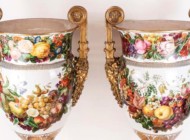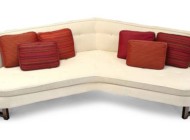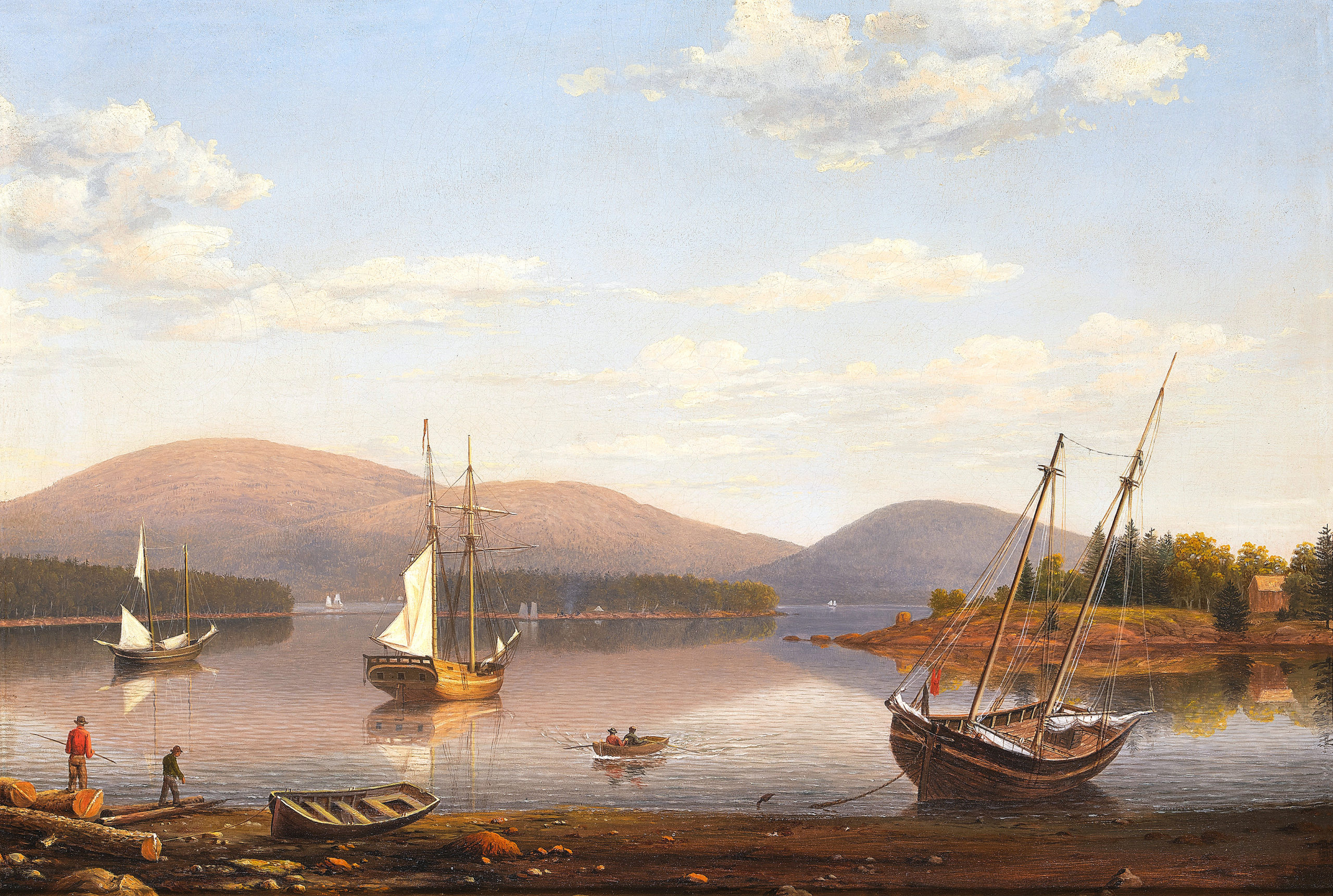
The top lot of the entire series of auctions of the Wolf Family Collection, and a new world auction record for artist Fitz Henry Lane, was established when “Bar Island and Mount Desert Mountains from Somes Settlement” realized $6,079,500. Oil on canvas painted in 1850, it measured 20-1/8 by 30-1/8 inches ($1/1.5 million).
Review by Madelia Hickman Ring, Catalog Photos Courtesy Sotheby’s
NEW YORK CITY — In our auction coverage over the years, we have often quoted auctioneers observing that masterpieces will always bring high prices. So, when the family of Erving (1926-2018) and Joyce Wolf (1927-2022), well-respected and selective collectors of largely American fine and decorative arts, decided to put their parents’ collection up for auction, it was an opportunity for buyers to acquire museum-quality pieces, the likes and caliber of which come to market only infrequently. By the time the final gavel fell on the last lot, in a sale of more than 60 lots of books from the Wolf’s art reference library, the final tally was $68,237,926, with nearly 98 percent of all 890 lots trading hands successfully.
“The tremendous success of the collection is a tribute to the life and legacy of my family whose collective curiosity and passion for discovery will be treasured by many for generations to come,” said Mathew Wolf.
The Spirit of America
Sotheby’s offered the Wolf Family Collection in ten sessions April 19-22 and 24-25. The first session — conducted at 6 pm on Wednesday, April 19, was titled “The Spirit of America” and featured 58 lots of the family’s top masterworks, across the categories of American fine art, early American furniture, design and Chinese export works of art. The session was “white glove,” indicating that all lots traded successfully, and achieved a total of $38,743,700. The value not only bested the session’s aggregate high estimate by more than 50 percent but a majority of lots exceeded their high estimates.
After the session, Jodi Pollack, Sotheby’s chairman and co-worldwide head of Twentieth Century Design, commented, “Last night’s inaugural evening sale of the Wolf Family Collection, which encompassed American art, sculpture, furniture and decorative arts, affirmed Joy and Erving Wolf’s unparalleled vision and style, and was a testament to the quality of works in every category throughout the collection. Underpinned by their exquisite taste and art that exemplified the essence of the American dream, the collection soared past its high estimate, with deep bidding across the sale, including prolonged bidding battles for several pieces…As one of the finest collections and last of its kind to celebrate American artistry in all its forms, the Wolf Collection was a momentous occasion for the American art and design markets and beyond.”
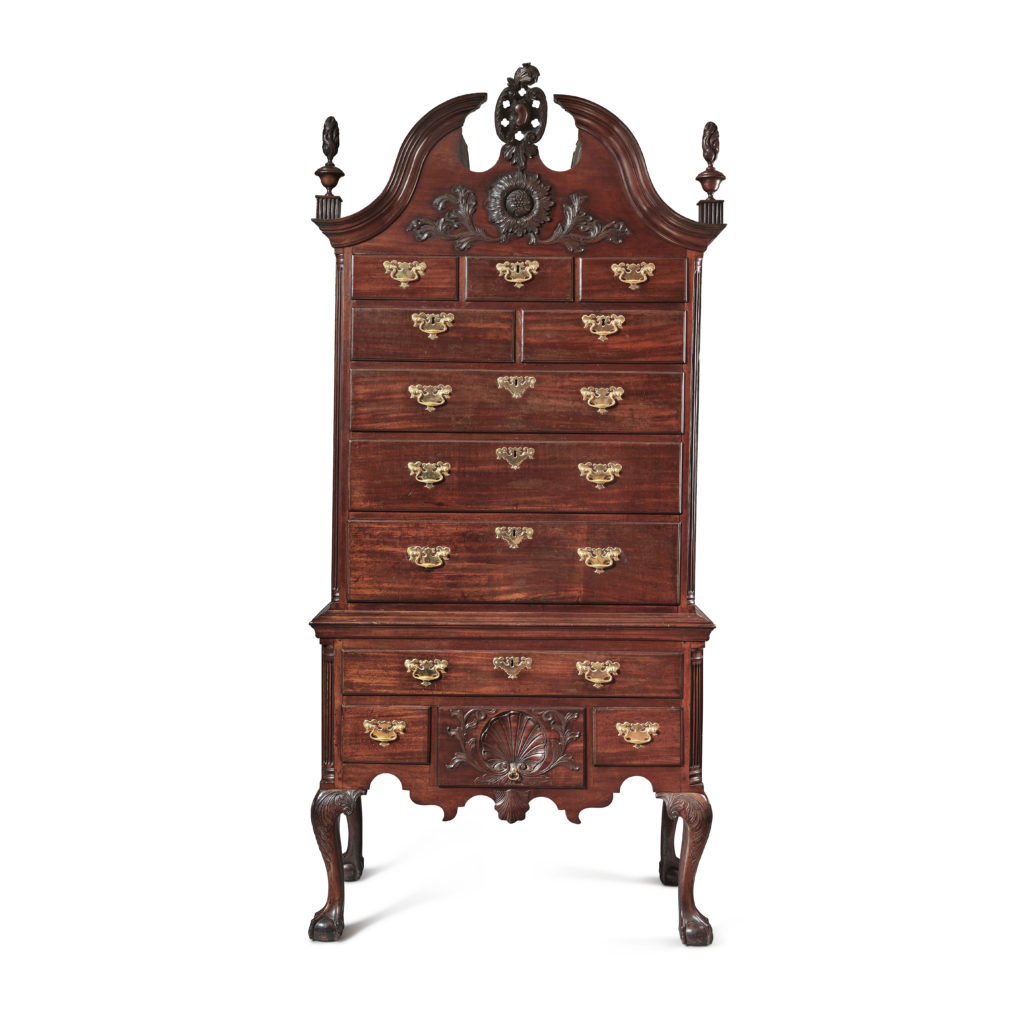
“It was a great example of high-style baroque furniture made in Philadelphia and was wonderfully intact,” said Erik Gronning, referencing this circa 1755 Chippendale mahogany bonnet-top high chest of drawers, carving possibly by Samuel Harding of Philadelphia, which rose to $241,300 and led the category
of early American furniture ($120/180,000).
Earning $6,079,500 and besting not only its estimate of $1/1.5 million but surpassing the previous $5,506,000 world record auction price for the artist — a record that had stood since 2004 — was Fitz Henry Lane’s “Bar Island and Mount Desert Mountains from Somes Settlement,” an oil on canvas masterwork the Wolfs had acquired from Hirschl & Adler in 1981. According to Erik Ronnberg and Sam Holdsworth, with the Fitz Henry Lane Online Catalogue Raisonné, the 1850 composition “must have been one of Lane’s earliest Maine paintings,” painted during the artist’s first cruise through Penobscot Bay. It is considered the most accomplished in terms of its treatment of light and landscape.
“It was well-admired during the preview and got a lot of participation during the sale,” said Kayla Carlsen, Sotheby’s senior vice president and head of American art. “I knew it would do well, but I didn’t foresee it breaking the record.” She confirmed a private collector had the winning bid.
“It was a good day for American art. It’s been a very long time since so many major names were offered in one place; it grabbed the attention of the market,” Carlsen continued. “The Wolfs were iconic in the American art space because of their involvement at the Met, and because they were buying over so many decades. Their collection drew interest and participation from people who knew them as well as from collectors who have both been active recently and older collectors who have not bought recently but who came out [for this collection] specifically. We also saw new collectors as well as interest across categories, which is what we hoped for.”
The summery feel evoked by Winslow Homer’s (1836-1910) “On the Beach at Marshfield” appealed to bidders and closed at $4,295,000, well ahead of its $2/3 million estimate and high enough to warrant a second-place finish in the sale. The oil on canvas had hung prominently in the artist’s Kettle Cove cottage on Prout’s Neck. Upon Winslow’s death, the painting and the related sketch he used passed to his brothers, Charles and Arthur, who identified the scene as Marshfield, Mass. It was painted around 1872, when Homer explored views of American leisure and summer resort life.
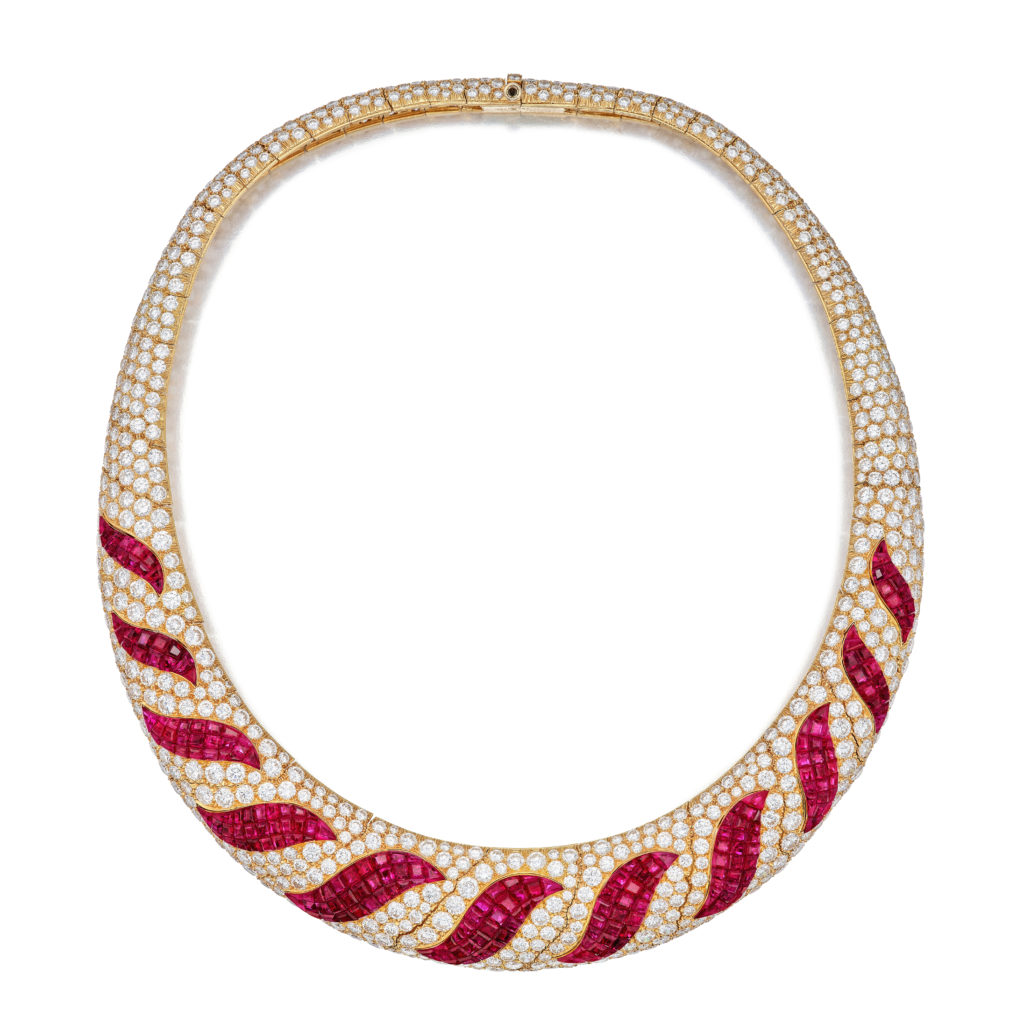
This “mystery set” ruby and diamond necklace by Van Cleef & Arpels topped the Exceptional Jewels sale at $673,100 ($300/500,000).
Rounding out the top three fine art highlights but keeping to a similar seasonal theme was “Summer Sea Window” by Marsden Hartley (1877-1943), which earned $3,750,500 and became the third highest selling work by the artist. Made circa 1939-40, “Summer Sea Window” was one of the latest still life paintings done before Hartley’s death and demonstrates the influence the European modernists such as Henri Matisse, Paul Cézanne and Pablo Picasso had on the artist. It is one of a small group of works made, all featuring window views overlooking Baker’s Island in Penobscot Bay.
Sotheby’s achieved a new world record for a work by American architect Frank Lloyd Wright when it sold the ceiling light from the Francis W. Little House in Peoria, Ill., for $2,903,500. Described in the catalog as epitomizing Wright’s Prairie Style of design, the light was made around 1902-03 and was published in Thomas A. Heinz’s Frank Lloyd Wright: Glass Art (London, 1994). It is one of just two examples made for the Little house, the other example is in the collection of the Saint Louis Art Museum.
A fall-front desk and chair from the Charles Millard Pratt House in Ojai, Calif., was designed by Greene & Greene and created in the Pasadena, Calif., workshop of Peter Hall. The Pratt House was one of five “Ultimate Bungalows” created by brothers Charles Sumner Greene (1886-1957) and Henry Mather Greene (1870-1954); its furnishings were site-specific. When the contents of the house were disassembled and sold in 1985, when the Wolfs acquired the chair and desk, the desk set a record for a work by Greene and Greene. Offered together now, both pieces achieved $1,143,000.
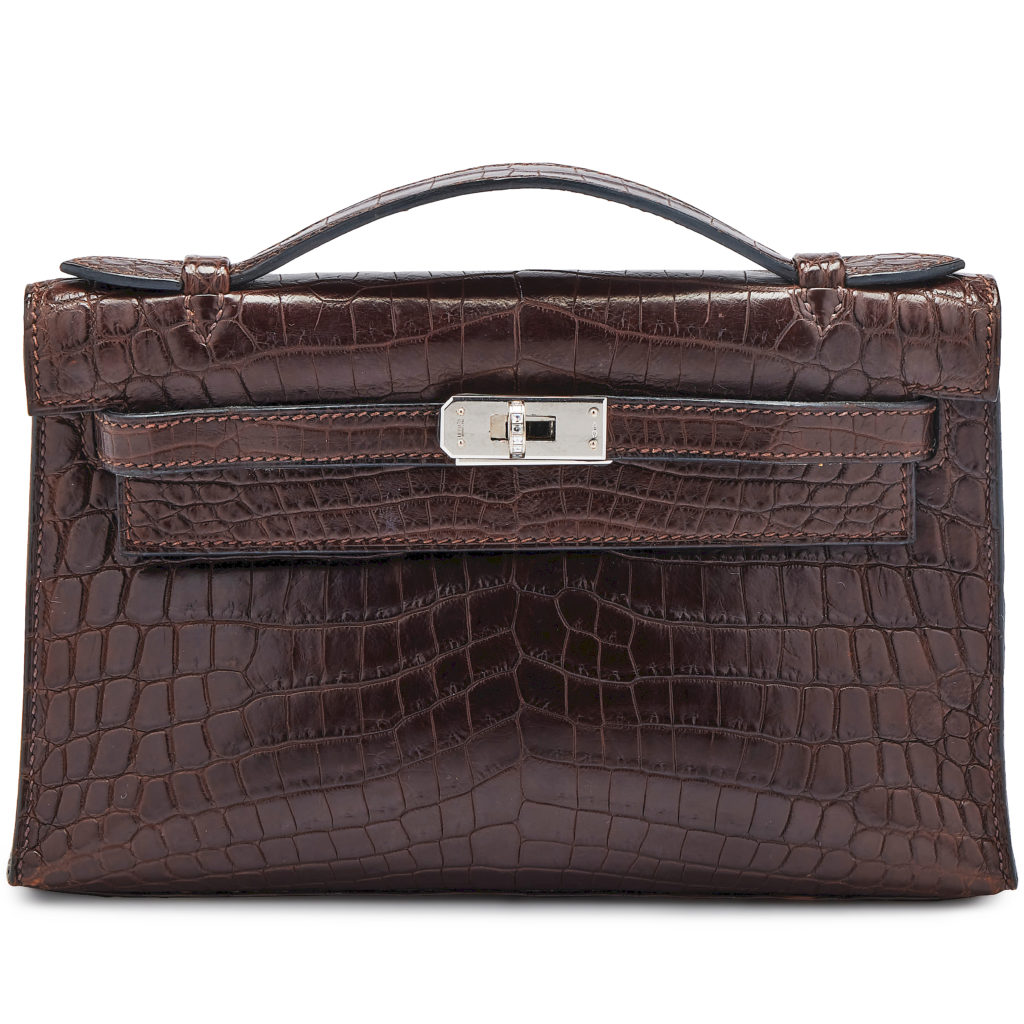
This 2006 Hermès Marron Fonce matte Niloticus crocodile Kelly Pochette with diamonds and white gold was snapped up for $40,640. It was the highest selling lot in the 9-lot sale of luxury handbags ($20/25,000).
“They had great taste and bought the best; the results show that,” affirmed Erik Gronning, Sotheby’s senior vice president and head of the Americana department. “The sale was very exciting. Walking through the preview was like walking through a museum. The Wolfs’ Collection was the epitome of aspirational living and showed the very best way to collect in the 1970s, 80s and 90s”.
For collectors whose tastes run towards the Eighteenth Century, a handful of lots in the evening session appealed, notably the Palmer-Franklin Chippendale mahogany bonnet-top high chest of drawers, which realized $241,300 from a private collector and underbid by Woodbury, Conn., dealer David Schorsch.
Other early Americana in the evening session included the Hollingsworth Family pair of Chippendale mahogany side chairs, attributed to Thomas Affleck, Philadelphia, circa 1770, which had been published in both Horner’s Blue Book: Philadelphia Furniture, 1682-1807: William Penn to George Washington (Philadelphia, 1935) and as a “Masterpiece” example in Albert Sack’s The New Fine Points of Furniture (New York, 1993). The chairs achieved $406,400, while $330,200 was paid for the Lambert Family Chippendale mahogany side chair, which had carving attributed to Nicholas Bernard, Philadelphia, circa 1750. A single Queen Anne walnut compass-seat open armchair, also from Philadelphia, circa 1755, that had been in the Philadelphia Museum of Art’s 1999 exhibition, “World Goods: The Arts of Early Pennsylvania, 1680-1758” earned $762,000. A Chippendale mahogany serpentine chest of drawers from Salem, Mass., that had been in “American Rococo: Eighteenth Century Elegance in Ornament” at the Metropolitan Museum of Art in 1992 found a new home for $317,500.
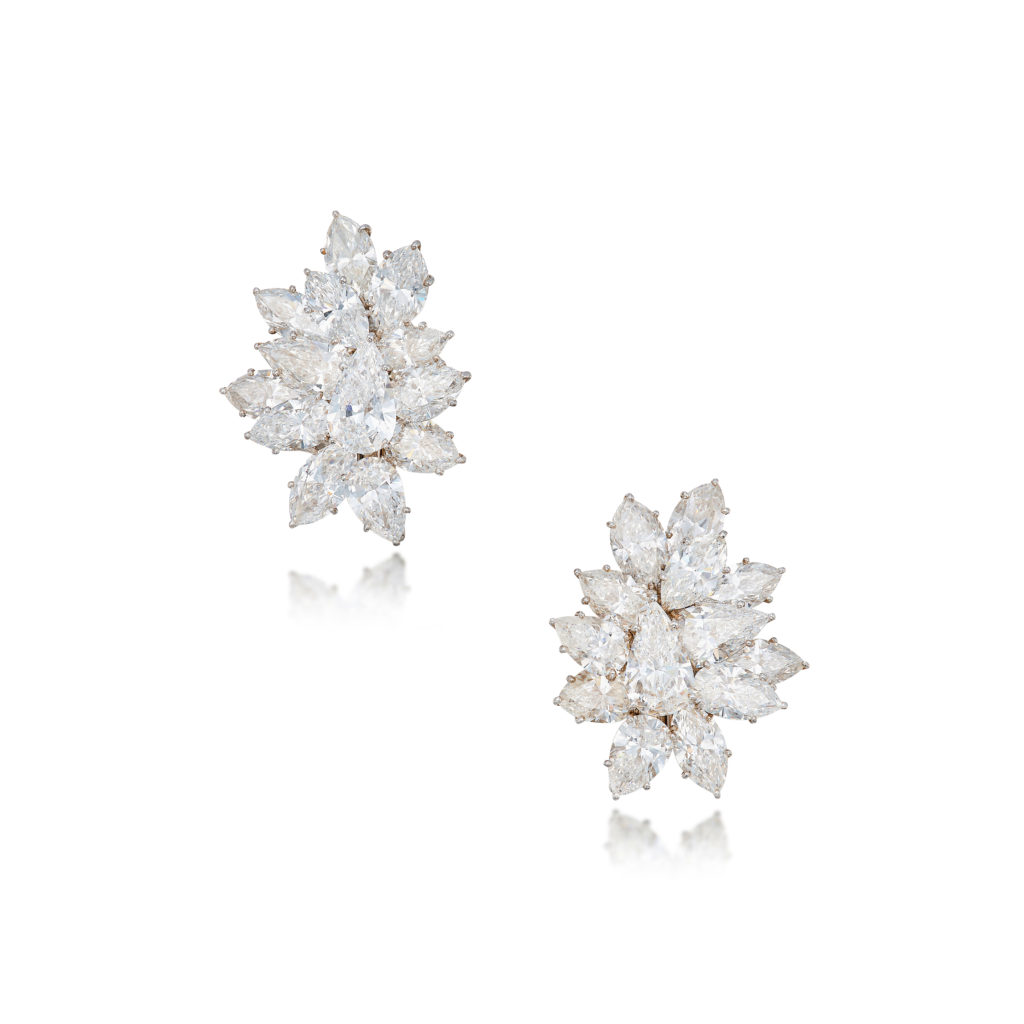
This pair of platinum and diamond earclips, circa 1990, were set with marquise-shaped and pear-shaped diamonds and made by Jacques Timey for Harry Winston. Weighing approximately 14 dwts, the pair made $571,500 ($180/220,000).
Exceptional Jewels
The morning of April 20 saw 105 lots of jewelry cross the block; like the session the night before, all lots traded successfully and the sale realized $8,042,656. At the top of the sale at $673,100 was a Van Cleef & Arpels “mystery set” ruby and diamond necklace; it was followed at $584,200 by a “mystery set” ruby and diamond clip-brooch, also by Van Cleef & Arpels.
Forging America
A boutique-sized sale of just 18 lots of the most historically significant bronzes in the Wolf’s collection were offered in the early afternoon on April 20. All but two of the lots sold for a sale total of $2,303,780. Bringing $431,800 was Augustus Saint-Gaudens’ (1848-1907) “Diana of the Tower,” a 39½-inch-tall version of the sculptor’s 13-foot-tall statue made to stand atop Madison Square Garden.
Gaston Lachaise’s (1882-1935) “The Peacocks” followed at $330,200. One of just 13 models made, and with six in public collections, the Wolf’s copy stood 23 inches tall and had been published in eight reference works and exhibited in two exhibitions.
Rounding out the leaderboard in that sale was “Pursuit of the King of the Herd” by Alexander Phimister Proctor (1862-1950), which ran to $279,400. It was also a nod towards the Wolf’s keen appreciation of Western American art.
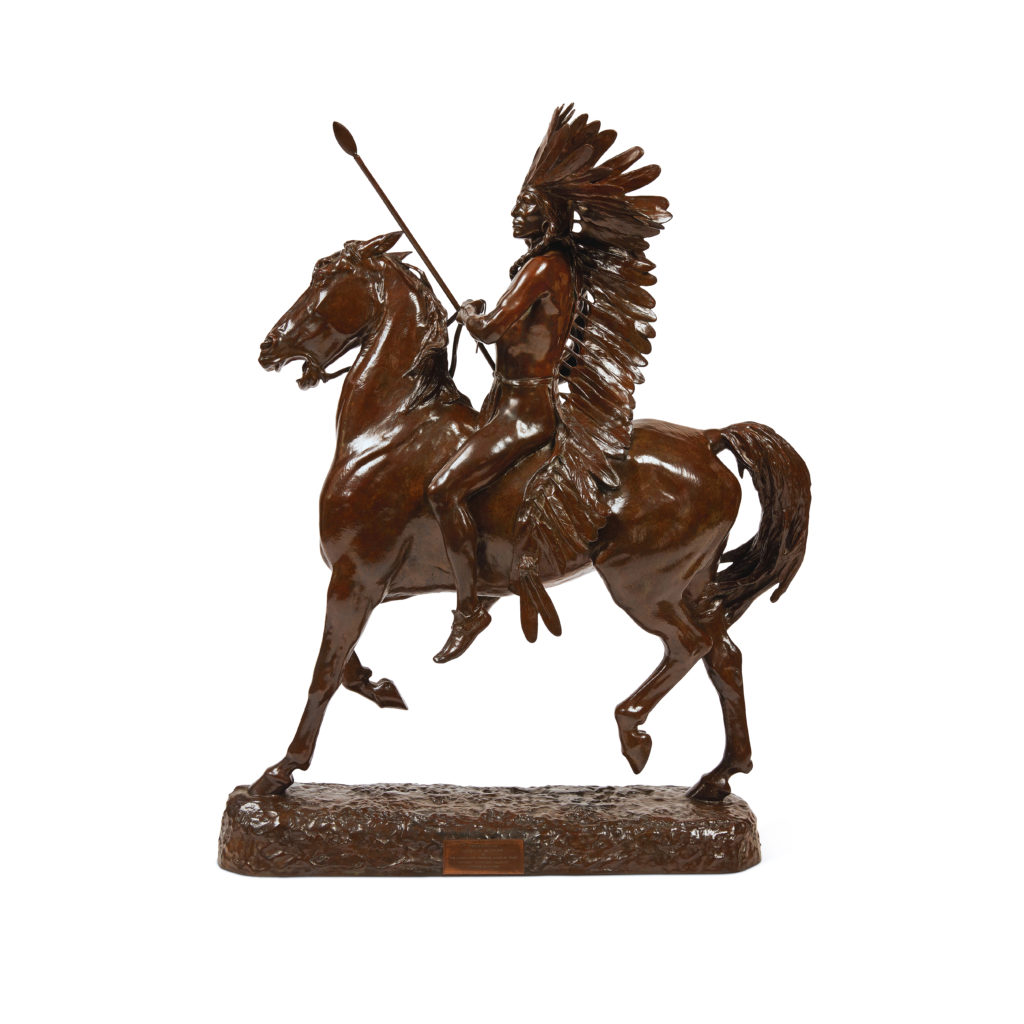
This large 39-inch-tall bronze “Indian Warrior” by Alexander Phimister Proctor sold for $482,600; it is one of 12 known casts, nine of which reside in museum collections ($100/150,000).
Modern America
Later in the afternoon on April 20, the session titled “Modern America: The Wolf Family Collection” presented an even 70 lots that capture the aesthetics of an evolving and developing Twentieth Century United States. With a sell-through rate of nearly 92 percent, the sale totaled $5,311,013 and was led at $635,000 by a monumental Teco pottery vase designed by Frank Lloyd Wright for the Susan Lawrence Dana House in Springfield, Ill., which is considered one of Wrights largest and most decoratively ambitious Prairie-style buildings.
Showcasing Tiffany Studios’ masterful integration of glass and metalwork was an eight-light Moorish “Prism” chandelier that was made circa 1905 and more than doubled its high estimate to reach $381,000.
Maurice Brazil Pendergast’s (1858-1924) jewel-toned “Girls at the Inlet,” painted around 1918 and during the artist’s final decade while he was living in New York City, brought $317,500. The beach theme was one that would dominate the artist’s oeuvre from 1909 and is indicative of the influence of landscapes by Paul Cézanne and classical statuary.
Glorious America
Growing up in Wyoming, Erving Wolf had a particular passion for art of the American West and the Wolf’s collection celebrated that passion in the session “Glorious America: The Wolf Family Collection.” Taking place in the late afternoon of April 20, and offering just 54 works, the sale raked in $5,334,381 and was more than 96 percent sold, by lot.
Bringing the top price for the session, and setting a record for a bronze by artist Henry Merwin Shrady (1871-1922) was “Elk Buffalo,” a 21-inch-tall sculpture cast by Theodore B. Starr that earned $482,600, nearly twice its high estimate.
“The Indian Warrior” by Alexander Phimister Proctor had previously been owned by Geraldine Rockefeller Dodge, whose collection was sold by Sotheby’s in 1975, when it was acquired by the Wolfs. One of just 12 known casts of a 39-inch-tall, large size and brought $482,600, not a record for the artist but one of the highest prices ever paid for his work at auction.
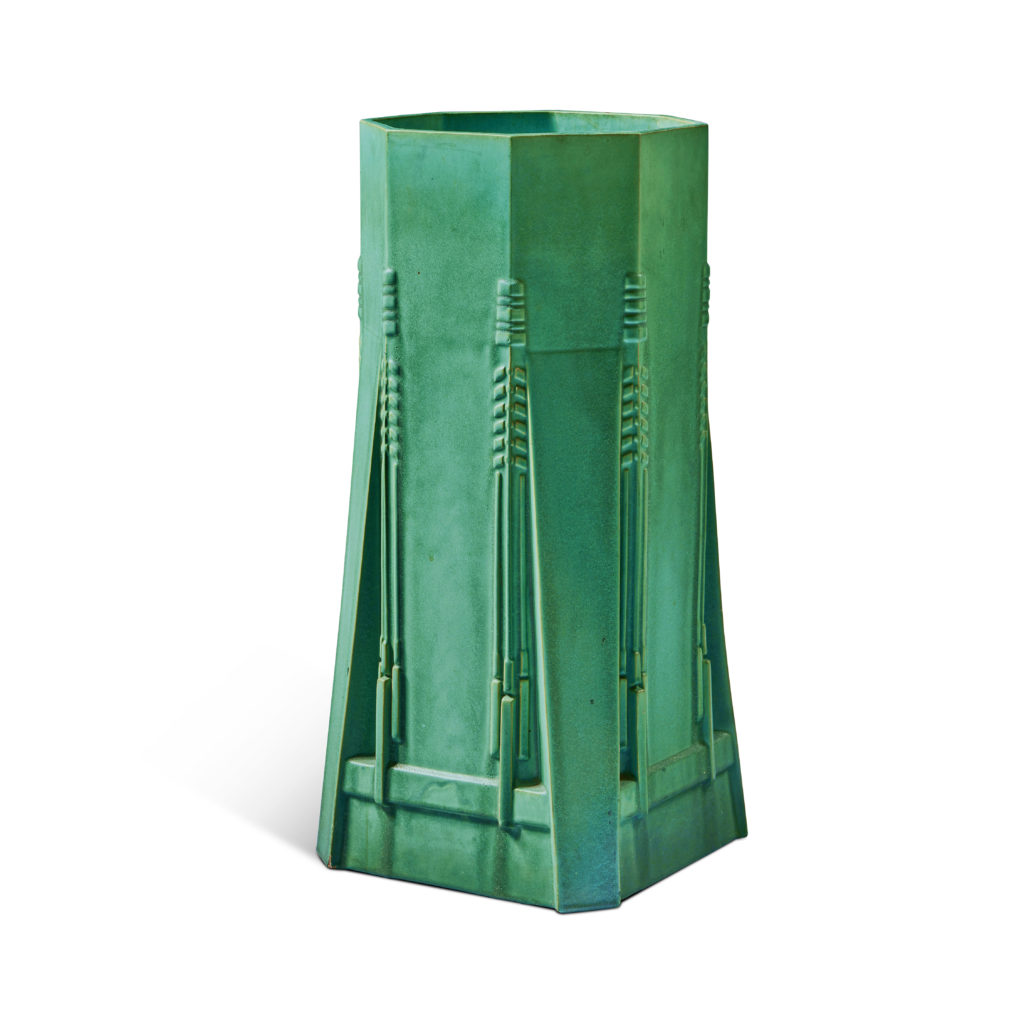
Monumental at 24¼ inches tall, this vase, designed by Frank Lloyd Wright circa 1902 for the Susan Lawrence Dana House and made by Teco Pottery, Chicago, led the “Modern America” sale at $635,000. It demonstrates the signature matte green glaze characteristic of Teco and is further embellished by sumac leaves on the sides ($150/200,000).
Cross-Currents in America
The morning of April 21 began with nearly 150 lots that “reflected the spirit of cross-cultural exchange between America, China and Europe across the centuries.” More than 98 percent sold by lot, the session tallied $4,230,370.
A watercolor on paper of a woman gathering twigs for fuel by Winslow Homer was painted in 1883 after a trip to England, his second and final trip abroad. During this trip, he settled in relative isolation in the small fishing village of Cullercoats on the North Sea, whose inhabitants inspired him. “The Faggot Gatherer” led the sale at $304,800.
Chinese export porcelain dominated the highest-flying lots in the session. Capping the category was a Transitional period (circa 1640) Chinese blue and white “Promotion” Sleeve vase, 16¼ inches tall, that had been in the collection of President Herbert Hoover (1874-1964) and brought $203,200. Created at a time when artisans had relative freedom to innovate new themes, the vase featured a narrative scene of officials examining an archaic vessel to officials. The same price was achieved for a Chinese Qing dynasty famille verte “ladies” rouleau vase, Kangxi period, which stood 18-3/8 inches tall and exhibited brilliantly painted and enameled decoration of noble ladies enjoying various leisure pursuits.
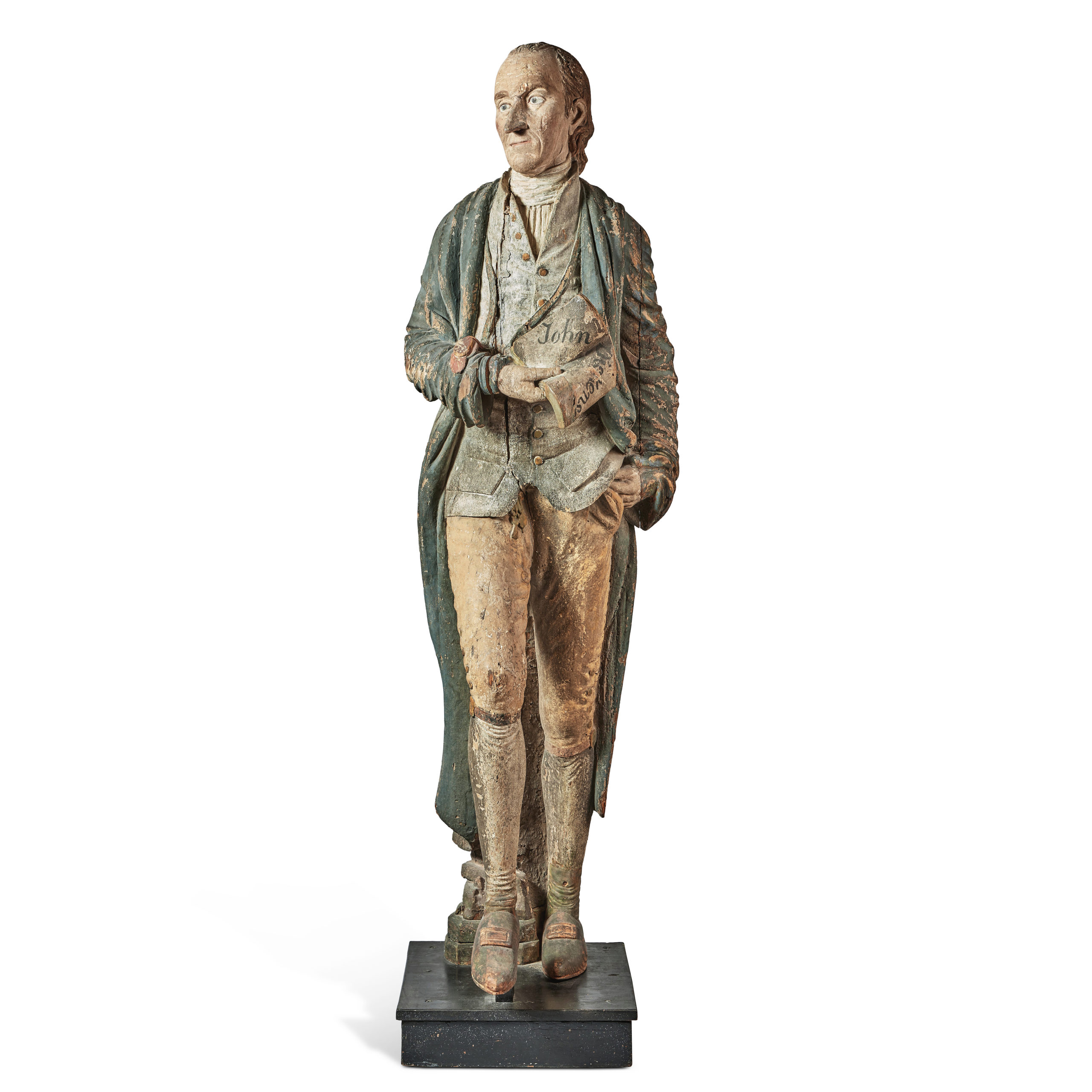
Attributed to William Rush, “John Dickinson,” carved and polychromed white pine, circa 1787-90, stood 74½ inches tall and went to a dealer on the phone, for $69,850 ($40/60,000).
Building America
The afternoon of April 21 showcased almost 150 lots of fine and decorative arts that speak to, and embody, early American history and offered a broad range of material, from furniture, needlework, silver, metalworks, ceramics, and fine and folk art. A final overall value of $2,261,997 with a sell-through rate of more than 93 percent was achieved in the session, which reached its apex at $165,100 with “The Puritan” by Augustus Saint-Gaudens, a 30½-inch-tall bronze model of the larger work commissioned in 1882 for Stearns Square in Springfield, Mass.
Early American furniture dominated the upper tiers of the prices realized, with a set of 12 Chippendale mahogany side chairs, made in New York City circa 1770 for the Clarkson Family, earning $139,700 from a buyer who outbid Schorsch. The set is considered exceedingly rare for having remained intact since they were made and are identified in the catalog as “the largest set of American Chippendale seating furniture with cabriole legs known.”
The Apthorp Family Queen Anne walnut side chair, with carving attributed to John Welch (1711-1789) of Boston, circa 1735, rose to $114,300, well ahead of its $50/80,000 estimate, and underbid by Schorsch. Originally owned by English-born merchant Charles Apthorp (b 1698), the chair demonstrates hallmarks of high style seating furniture made in Boston in the 1730s and 1740s, including small ball-and-claw front feet and squared rear feet, balloon-shaped seats, backs with bow-shaped splat shoes, veneered splats and pierced shell-carved crests; other chairs from the same set are in private and institutional collections, including Chipstone Foundation and the Metropolitan Museum.
Also crafted in Boston but made circa 1725 and about 10 years earlier than the Apthorp chair was the Pickering Family William and Mary figured walnut and maple flat top high chest of drawers, which descended in the Salem, Mass., family of deacon Timothy Pickering (1702-1778). Deemed as a “masterpiece” example by Albert Sack, it was published in his The New Fine Points of Furniture (1993), where it was additionally described as “a jewel…that excels in compact proportion, condition and magnificent patina.” It found a new home for $107,950, underbid by Schorsch.
A life-sized carved and polychrome sculpture of founding father John Dickinson (1732-1808) and attributed to Philadelphia carver William Rush (1756-1833) that had exhibition history at the Dickinson Mansion in Dover, Del., and the Smithsonian Institution in 1962 finished at $69,850, to a trade buyer on the phone.
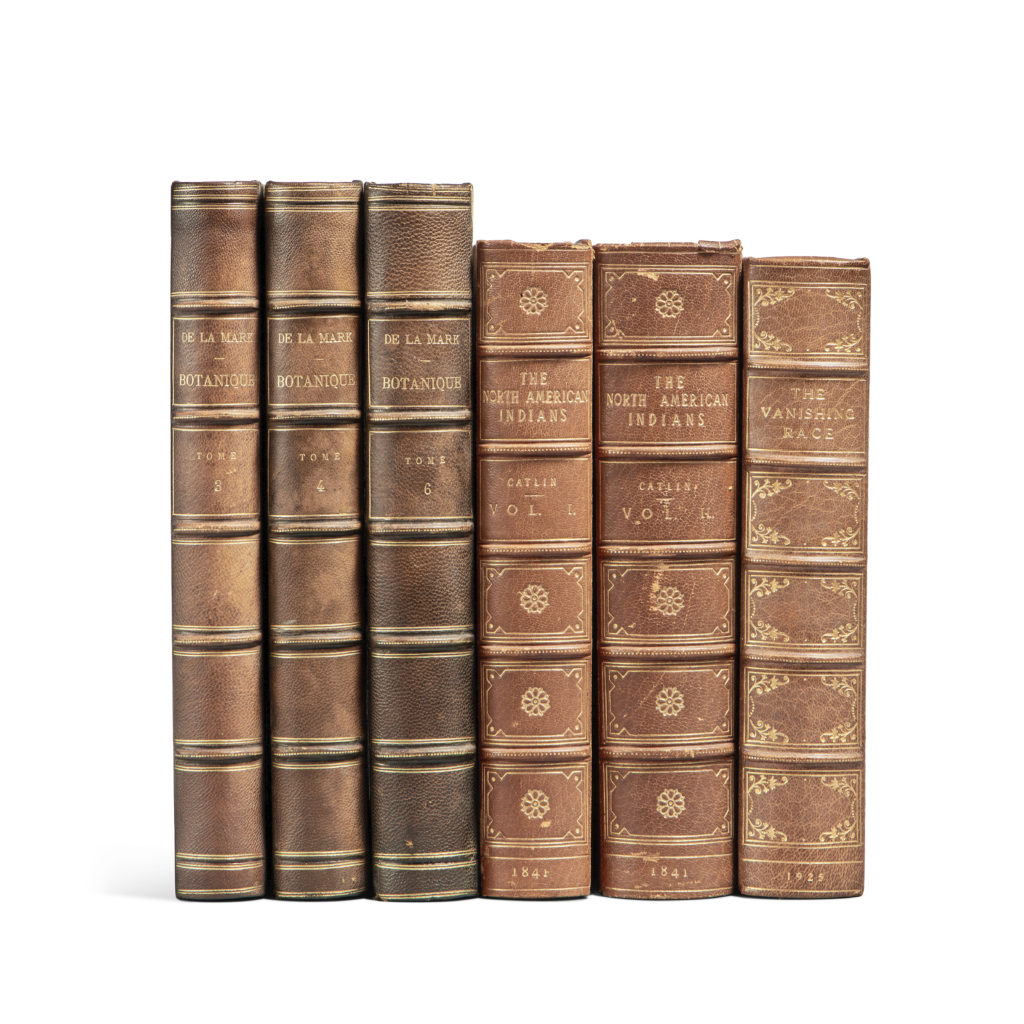
Bringing $27,940, the highest price in the sale of the Wolf’s library of art reference books was a lot of approximately 90 volumes focused on Native American art and culture ($300/500).
America Without Reserve
Nearly 200 lots of works across multiple categories were offered without reserve in a session that began at noon on April 24. The session continued the tradition of “white glove” status, with all lots selling for an aggregate price realized of $1,460,246.
A Nineteenth Century Qing dynasty Chinese ruby red enameled double-gourd vase, just 6-3/8 inches tall topped the sale at $117,800, more than 35 times its high estimate. It was followed at $50,800, for Henry Kirke Brown’s (1814-1886) bronze “Panther With Cubs,” which had been exhibited at both the Metropolitan and Denver Art Museums. Demonstrating the breadth of the session, and rounding out the leaderboard at $48,260 was a series of five glazed tiles with geometric figures by Sol Lewitt (1928-2007)
Luxury Handbags: Vintage Icons
More than two dozen luxury and vintage handbags by Chanel, Gucci, Hermès and Louis Vuitton were auctioned in a morning session on April 25. It was not surprising that all lots sold, and the session added another $285,242 to the final total. Bags by Hermès dominated the list of top-ten results, with a 2006 Marron Fonce matte Niloticus crocodile Kelly Pochette with diamonds and white gold, a lambskin lined interior bagging the top price of $40,640. A 2005 black Porosus crocodile Kelly Pochette bag with palladium hardware rose to $21,590, just ahead of the $20,320 paid for a 1983 rouge Vif shiny Crocodile Kelly Sellier 35 bag with gold hardware and monogrammed “DRW.”
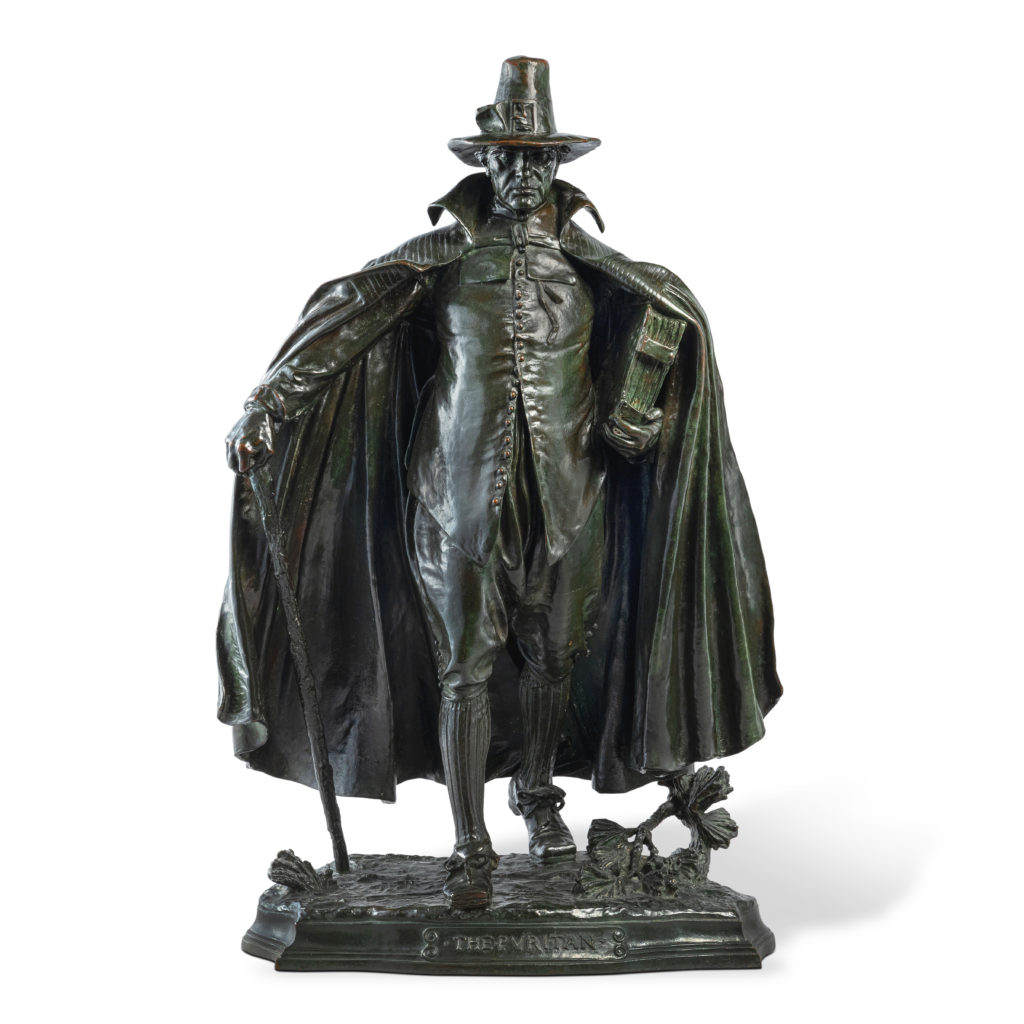
The Wolfs acquired this 30½-inch-tall model of Augustus Saint-Gaudens’ “The Puritan” from the estate of Geraldine Rockefeller Dodge in 1975; it sold for $165,100
($120/180,000).
Ex Libris: Art Reference Library
The final session on the afternoon of April 25 proffered 63 lots of books from the Wolf’s voluminous art reference library, which generated another white glove result tallying $264,541. At the forefront was a lot of about 90 volumes relating to Native American art and culture that bidders pushed to $27,940, a significant increase from the $300/500 estimate. The lot included Thomas Donaldson’s The George Catlin Indian Gallery in the U.S. National Museum; Thomas I. McKenney’s History of the Indian Tribes of North America, Indian Life and Indian Lore; Indian Days of the Long Ago by Edward S. Curtis; and The American Indian on the New Trail by Thomas C. Moffett.
A lot of approximately 100 volumes comprising American Impressionist art monographs and survey books related to American artists abroad yielded $20,320, while the third highest price in the sale was $16,510 that was paid for a 23-volume group of books on important jewels and jewelers.
After the final session concluded, Pollack said “This unprecedented sale series is reflective of the superlative quality and unparalleled depth of the Wolf collection. Sotheby’s had the great privilege of holding a very close and special relationship with the Wolf Family from the onset of their collecting, and it has been an incredible honor to celebrate their unique vision and impeccable taste, culminating in one of the greatest collections of American art and objects of its kind.”
Prices quoted include the buyer’s premium as reported by the auction house. For information, www.sothebys.com or 212-606-7000.































